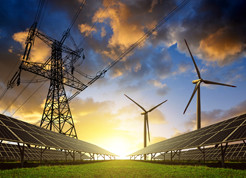Donald Trump's surprise victory in the hotly contested US presidential election has sent shockwaves through many industries including the energy sector.
Fears have been sparked that clean, green fuels - such as solar, wind, hydro, fuel cells - are for the chop, with the threat that the current administration's commitment to policies on climate change facing reverse.
Not necessarily so. There are good reasons for investors to continue to back the development of technology for alternatives to dirty fuels such as oil and coal.
'Many businesses in the space are commercially viable without subsidy or other policy support,' state analysts at Cantor Fitzgerald Europe.
'The outlook for many companies in the new energy space was finally progressing away from reliance on government handouts, with a number poised to benefit from the expected growth for the sector,' explains Adam Forsyth, research analyst at Cantor.
New energy and clean technology has been a difficult area, and government handouts have certainly played a key role in their development.
But there has also been rapid progress, boosting efficiency and helping to narrow the gap of energy generation between old and newer sources.
'Many alternative energy companies have been over reliant on policy support which has been variable, and is now even more uncertain given the US election outcome and a potentially fracturing Europe,' Forsyth admits.
'But this has not prevented over 700GW (gigawatts) of renewable generation being installed around the world, and indeed the annual market potential here could be in the order of $500bn by 2020,' he says.
In Forsyth's view, too much had been made of the role of politicians and subsidies in the alternative energy sector, ignoring the fact that renewable energy capacity has already changed energy markets globally.
'A global policy consensus on the environment is at risk given the US election outcome, with the progress made at the Paris conference of the parties to the UN Framework Convention on Climate Change now less reliable,' he says. 'But this does not affect our investment case.
'Existing renewable capacity has already changed power markets around the world and that is what now drives investment opportunities,' the analyst states.
Forsyth believes that some of the better opportunities come from a market-led 'new energy wave' around four sub-sectors:
> Smart solutions and efficiency
> Flexible generation and storage
> Independent supply and distributed power
> Renewable development opportunities
Many of the opportunities, in Forsyth's opinion, are right here listed on the AIM market. These include:
AFC Energy (AFC:AIM) 23p (Cantor Fitzgerald target price, 77p).
'AFC, the industrial fuel cell power company, is at the point of commercialising a distributed generation fuel cell targeting key niche markets in the industrial sector. The company has made real progress in the past year and looks set to deliver commercial sales in the near future.'
CyanConnode (CYAN:AIM) 0.2p (target price 0.7p)
'The smart meter developer is now a leader in narrowband wireless mesh networks, with the key deployment for the company’s technology in the smart meter space. In particular, there is a strong focus on the developing world where the benefits of smart meters are strongest.
'The company is now at an inflection point as it moves towards genuine and potentially significant revenues - but clearly there are risks, with the immediate future highly dependent on a small number of transactions.'
Flowgroup (FLOW:AIM) 8.38p (target price 21p)
'Flowgroup is exploiting the growing demand for independent energy providers and for more sophisticated and efficient solutions to home power and heating needs.
'It is growing rapidly as an independent energy supplier in the competitive UK market, and this line of business has evolved to become the company’s core operation, alongside distributing efficient home energy solutions.
'It is a growing favourite in terms of direct customers and is now the only recommended supplier of energy by Which?.'
Mytrah Energy (MYT:AIM) 43.75p (target price 130p)
'An Indian renewables developer, it has already built up a major portfolio of wind assets in India that are beginning to generate attractive cash flow.
'While funding has been expensive, the company is making progress on refinancing and looks set to continue to grow. It has a pipeline with great potential, and is also developing solar assets which the Indian government is strongly supportive of.'
OPG Power Ventures (OPG:AIM) 66.5p (target price 130p)
'Another company focused on the Indian market, OPG has principally been a developer of coal-fired power generation in India, but is now moving rapidly into renewables.
'Conservatively managed, OPG has been cautious about over levering and has developed its coal-fired portfolio with this in mind.
'It has low debt compared to other Indian power developers, and we see OPG’s delivery and continued strong operations as demonstrating its credibility as a power developer and operator in the Indian market.'
Plutus Powergen (PPG:AIM) 2.4p (target price 3.8p)
'A developer of flexible generation in the UK, Plutus is developing a strong portfolio of assets aimed at taking advantage of growing demand to support renewable energy generation.
'Another business with a strong pipeline, demographics for the company are favourable, with the UK renewables market having already grown from 4% of total capacity in 2004 to 20% in 2015.'
Windar Photonics (WPHO:AIM) 102.5p (target price 118p)
'Windar’s proprietary technology can create significant gains in output from wind turbines and can be retrofitted to existing units. Its technology results in increases in output of between 1% and 4% for turbines which directly translates into increased revenue and profit for manufacturers.
The business is now gaining commercial traction which should lead to much higher sales and, if it is seen as a critical feature, it could lead to Windar’s technology being adopted by many more turbine manufacturers.'
Good Energy (GOOD:AIM) 254p (target price 250p)
'A generator, purchaser and seller of renewable energy, it can compete in the independent energy space with lower churn and has shown good management of purchasing risk.
'The main risk to the business is whether it can gain traction with its customer base - it currently has almost 240,000 customers, but the growth rate has slowed slightly. However, we expect a return to stronger growth following a period of investment.'





